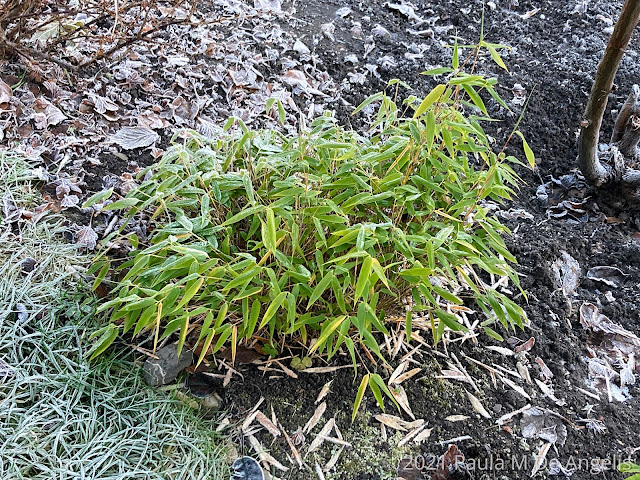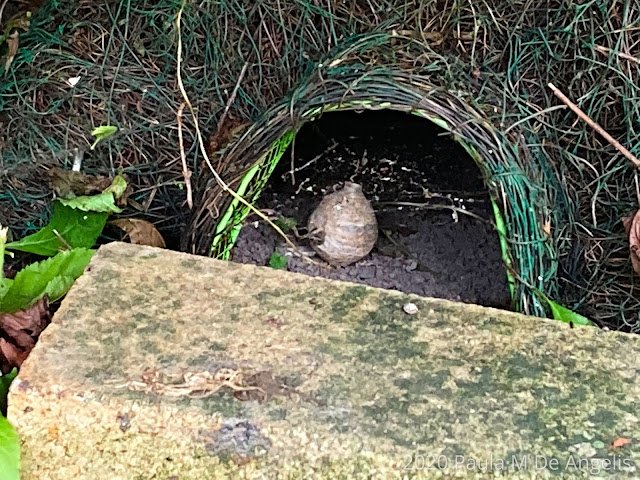We've had exceptionally warm weather for most of July, and it's done wonders for the garden. I call the last week in June/first two weeks in July the magic time in the garden. It's as though nature waves its special wand during this time and suddenly everything is transformed--the garden grows by leaps and bounds. I forget that from year to year; that nature takes care of itself for the most part. There have been years where the growth hasn't been so spectacular during this time; this year is not one of them. I imagine that the addition of new soil to the vegetable beds also helped, because I've never seen the potato plants grow so high as they've done this year. They have also formed berries, which I've never really seen before. This means that sexual reproduction is involved due to pollination; from what I've read online, most potatoes reproduce asexually from tubers, which are clones. So it's cool to see this aspect of their reproduction. I will harvest some of the potato berries after six weeks or so and try growing some potatoes from seeds next year.
Otherwise, the zucchini plants are producing zucchinis already, and the pumpkin and butternut squash plants show some developing fruit. The tomato plants are growing well and tomatoes are starting to develop. The cucumber plants have already produced two long cucumbers that taste very good. The bean plants are also thriving, but I don't see any beans hanging on them as of yet.
I bought a fair amount of perennials this year so that I don't have to fill in the empty spots in the garden with annual flowers each year. Some of the perennials I've bought are Coreopsis lanceolata (tickseed), Delphinium 'Magic Fountains' (larkspur), burgundy Gaillardia aristata (Great Blanket flower), Lythrum salicaria (purple loosestrife), Leucanthemum 'Banana Cream' (Shasta daisy), and columbine (akeleie in Norwegian). I've also gotten some perennials from my neighbor gardeners--Phlox and Polemonium (Jacob's ladder). All of them are growing happily. My forsythia bushes are growing, as are the potentilla (cinquefoil) bushes. The gladiolas are fairly tall now and some have started to flower, and the sunflowers have grown tall and have flowered. I planted the wild meadow seeds that I ordered online under the red currant bush where nothing usually grows; they took and the meadow flowers look so pretty. The pachysandra also are thriving; you know that from how they spread out. They like the shade, and are about the only plants that have done well under the krossved tree.
We didn't have many red currants or strawberries this year, but we do have many black currants as well as raspberries and gooseberries. This is the first year that the black raspberry plant (Rubus coreanus) is producing fruit; it is so good. The blackberry bushes are also starting to produce fruit. If you look quickly at black raspberries, they can be confused with blackberries, but they are not the same. It's been interesting to learn about the differences between them.
It rained heavily the past few days and that is always a bit tough on those plants/flowers that need support. After our four-day vacation I came back to the garden to find the sunflowers slightly bent over, and the tall tomentose goldquelle laciniata (a type of coneflower) that I have planted along the fence, completely bent over. Getting them to stand up straight again took some time and I had to attach them to the fence with strong wire in order to keep them that way.
Keeping the names of all the flowers straight is not easy, especially since I need to know both the Norwegian and English names because I speak with both Norwegians and non-Norwegians about garden-related things. It's easier with the vegetables: potato and tomato are the same words in Norwegian, zucchini is referred to as sommer squash (summer squash). Pumpkin is gresskar, butternut squash is butternut squash. Beans are bønner. There are different varieties of all of them, but the basic name remains the same.
Here are some photos of the garden as of this past week.
 |
Phlox flowers
|
 |
Coreopsis lanceolata (tickseed)
|
 |
Leucanthemum 'Banana Cream' (Shasta daisy)
|
 |
burgundy Gaillardia aristata
|
 |
butternut squash developing
|
 |
sunflowers happily growing near the compost bin
|
 |
how the back side of the greenhouse looks now after all the plantings
|
 |
a view of the greenhouse front and back
|
 |
cherry tomato plants and potato plants in the foreground
|
 |
summer aster to the right and pumpkin plants in front of it in the foreground
|
 |
the birdbath area surrounded by flowers, a rose bush, a bamboo plant and rhododendron
|
 |
the main flower garden with rose mallows, lavender, peonies, Japanese maple tree, polemonium
|
 |
wild meadow flowers (I planted the seeds under the red currant bush where nothing usually grows)
|
 |
pachysandra spreading out under the krossved tree (nothing else will grow there due to the shade)
|





























































